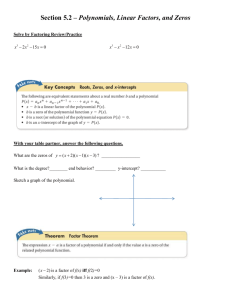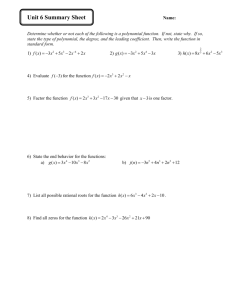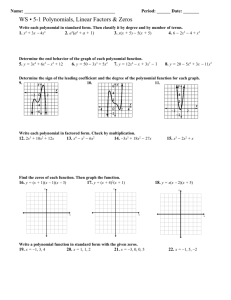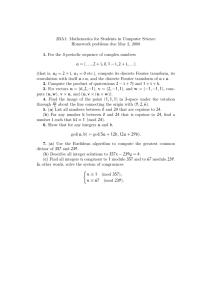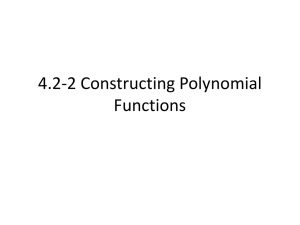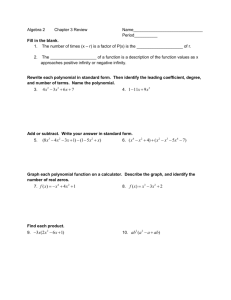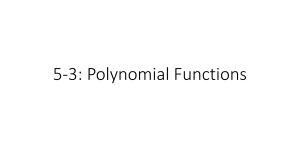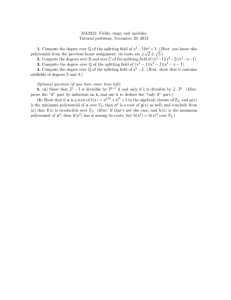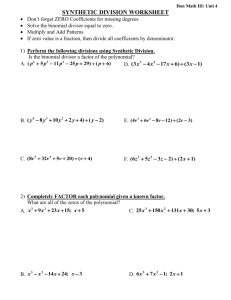Algorithms for Function Fields J ¨urgen Kl ¨uners CONTENTS K
advertisement
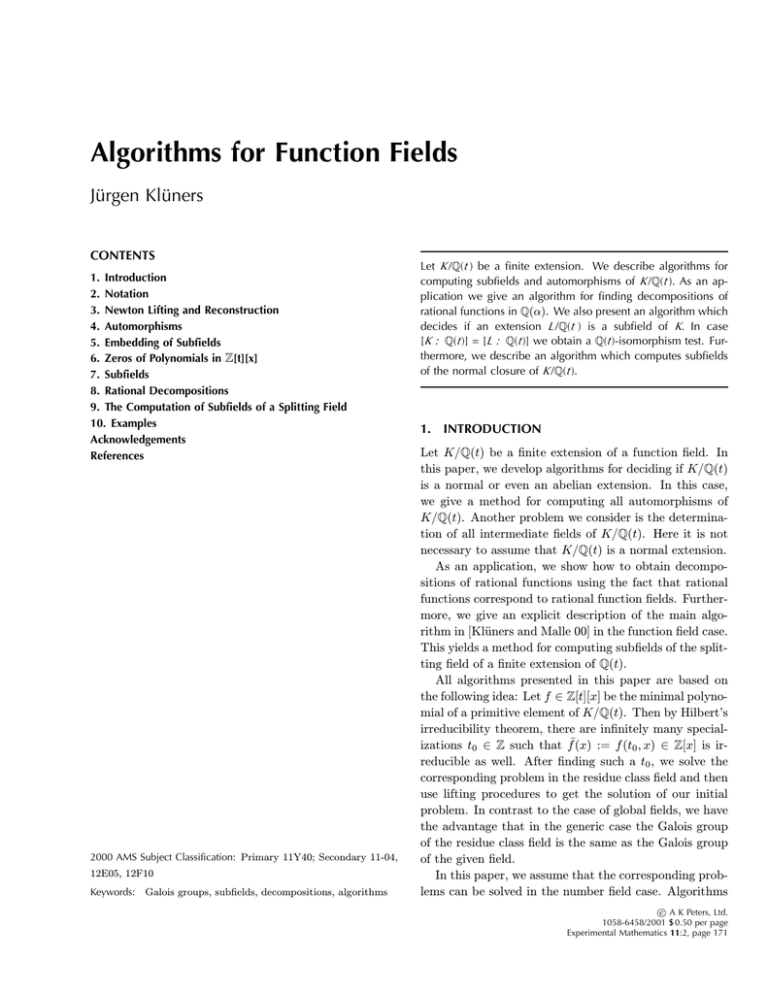
Algorithms for Function Fields
Jürgen Klüners
CONTENTS
1. Introduction
2. Notation
3. Newton Lifting and Reconstruction
4. Automorphisms
5. Embedding of Subfields
6. Zeros of Polynomials in Z[t][x]
7. Subfields
8. Rational Decompositions
9. The Computation of Subfields of a Splitting Field
10. Examples
Acknowledgements
References
2000 AMS Subject Classification: Primary 11Y40; Secondary 11-04,
12E05, 12F10
Keywords:
Galois groups, subfields, decompositions, algorithms
Let K /Q(t ) be a finite extension. We describe algorithms for
computing subfields and automorphisms of K /Q(t ). As an application we give an algorithm for finding decompositions of
rational functions in Q(α). We also present an algorithm which
decides if an extension L /Q(t ) is a subfield of K. In case
[K : Q(t )] = [L : Q(t )] we obtain a Q(t )-isomorphism test. Furthermore, we describe an algorithm which computes subfields
of the normal closure of K /Q(t ).
1. INTRODUCTION
Let K/Q(t) be a finite extension of a function field. In
this paper, we develop algorithms for deciding if K/Q(t)
is a normal or even an abelian extension. In this case,
we give a method for computing all automorphisms of
K/Q(t). Another problem we consider is the determination of all intermediate fields of K/Q(t). Here it is not
necessary to assume that K/Q(t) is a normal extension.
As an application, we show how to obtain decompositions of rational functions using the fact that rational
functions correspond to rational function fields. Furthermore, we give an explicit description of the main algorithm in [Klüners and Malle 00] in the function field case.
This yields a method for computing subfields of the splitting field of a finite extension of Q(t).
All algorithms presented in this paper are based on
the following idea: Let f ∈ Z[t][x] be the minimal polynomial of a primitive element of K/Q(t). Then by Hilbert’s
irreducibility theorem, there are infinitely many specializations t0 ∈ Z such that f¯(x) := f (t0 , x) ∈ Z[x] is irreducible as well. After finding such a t0 , we solve the
corresponding problem in the residue class field and then
use lifting procedures to get the solution of our initial
problem. In contrast to the case of global fields, we have
the advantage that in the generic case the Galois group
of the residue class field is the same as the Galois group
of the given field.
In this paper, we assume that the corresponding problems can be solved in the number field case. Algorithms
c A K Peters, Ltd.
°
1058-6458/2001 $ 0.50 per page
Experimental Mathematics 11:2, page 171
172
Experimental Mathematics, Vol. 11 (2002), No. 2
for the computation of subfields of algebraic number
fields are described in [Klüners and Pohst 97, Klüners
98]. In [Acciaro and Klüners 99, Klüners 97] algorithms
for the computation of automorphisms of algebraic number fields are explained.
All algorithms are implemented in the computer algebra system KANT [Daberkow et al. 97]. We give several
examples to demonstrate the efficiency of the algorithms.
Lemma 3.1. (Newton lifting.)
Let g ∈ Z[t][x] be a
polynomial, t0 ∈ Z, and β0 ∈ Q[t][α] such that g(β0 ) ≡
0 mod (t − t0 ) and a = (t − t0 ) z disc(f ) disc(g). Then
for every k ∈ N we can compute an element βk ∈ Q[t][α]
k
with g(βk ) ≡ 0 mod a2 and βk ≡ β0 mod a.
Proof: From (t − t0 ) z disc(f ) disc(g) we get that g 0 (β0 ) is
invertible in R/a. Its inverse ω0 can be computed using
the extended Euclidean algorithm. The elements βk are
now obtained using the above double iteration.
2. NOTATION
We consider finite extensions of Q(t). We assume that
these extensions are given by a primitive element α with
minimal polynomial f of degree n. By applying suitable
transformations, we can assume that f is a monic polynomial in Z[t][x]. The stem field Q(t)(α) of f is denoted by
K and the splitting field of f is denoted by N . The zeros
of f in N are denoted by α = α1 , α2 , . . . , αn . Throughout, G = Gal(f ) is the Galois group of f acting on the
roots α1 , . . . , αn .
In our algorithmic approach, we need to consider
residue class fields. Therefore, let t0 ∈ Z be chosen in
such a way that f¯(x) := f (t0 , x) ∈ Z[x] is irreducible. We
denote by ¯· the corresponding structures in the residue
class field, i.e., K̄ denotes a stem field of f¯, N̄ the splitting field of f¯. Ḡ is the Galois group of f¯ acting on the
roots ᾱ = ᾱ1 , ᾱ2 , . . . , ᾱn .
3. NEWTON LIFTING AND RECONSTRUCTION
Let R be a commutative ring with 1 and a an ideal of
R. Furthermore, let g ∈ R[x] be a polynomial and β0 ∈
R such that g(β0 ) ≡ 0 mod a and g 0 (β0 ) is invertible
modulo a. Then for every k ∈ N, we can compute βk
k
such that βk ≡ β0 mod a and g(βk ) ≡ 0 mod a2 using
the extended Newton lifting which avoids divisions. Here
we only give the algorithm. Details can be found in [von
zur Gathen and Gerhard 99, Algorithm 9.22]. Let ω0
be the inverse of g 0 (β0 ) modulo a. Then we can use the
following double iteration for i = 0, . . . , k − 1:
βi+1
ωi+1
≡
≡
i+1
βi − ωi g(βi ) mod a2
0
;
(3—1)
2i+1
ωi [2 − ωi g (βi+1 )] mod a
.
(3—2)
Let f, α, K, and n be defined as in Section 2. In the
following, we look at the special situation where R is the
equation order Q[t][α] := Q[t] + Q[t]α + · · · + Q[t]αn−1
and a := (t − t0 ) ⊆ R is the principal ideal generated by
t − t0 ∈ Z[t].
In our algorithm, we want to compute an element of the
form
n−1
X
bi αi (bi ∈ Q(t)),
β=
i=0
where we make the additional assumption that all denominators of the bi divide a given polynomial d ∈ Q[t].
Now let M := t − t0 ∈ Z[t] be a polynomial which is
prime to d. For a, b, c ∈ Q[t] with gcd(M, b) = 1, we say
that ab ≡ c mod (M k ) if and only if a ≡ bc mod M k . We
further say that
n−1
X
i=0
bi αi ≡
n−1
X
ci αi mod ak if and only if
i=0
bi ≡ ci mod (M k ) (0 ≤ i ≤ n − 1).
In our applications, we are able to compute γ =
Pn−1
i
k
i=0 ci α with β ≡ γ mod a . Knowing that all denominators of the bi divide d, the reconstruction of β from γ
can be done coefficientwise using the following lemma:
Lemma 3.2. (Padé approximation.) Let c, M = (t −
t0 )k ∈ Q[t] and k1 , k2 ∈ N with k1 + k2 < k. If there
exist a, b ∈ Q[t] with deg(a) ≤ k1 and deg(b) ≤ k2 such
that ab ≡ c mod (M ), then a, b can be computed efficiently
based on an extended gcd-algorithm. Furthermore, ab is
unique in this case.
The proof can be found in [von zur Gathen and Gerhard 99, Section 5.9]. If we want to use the above lemma,
it is important to have estimates for the degrees of a and
b in order to choose the needed precision k.
We denote by | · |∞ the negated degree valuation on
Q(t), i.e., | ab |∞ = deg(a) − deg(b). Let N/Q(t) be a finite
extension. We know that there exists a valuation of N
extending | · |∞ . We denote this valuation by | · |∞ , too.
Let f ∈ Q[t][x] be an irreducible polynomial. It is well
known how to compute the valuations of the zeros of f
in a splitting field N of f .
Klüners: Algorithms for Function Fields
Theorem 3.3. Let f = xn + a1 xn−1 +· · ·+an ∈ Q(t)[x] be
a monic polynomial and denote by α1 , . . . , αn the zeros
in a splitting field. Then we can recursively define 1 ≤
k1 < k2 < . . . < ks = n such that the following holds:
Pn−1
Proof: Clearly, β = d1 i=0 b̂i αi for some b̂i , d ∈ Q[t].
Denote by α1 , . . . , αn the conjugates of α. Then the conjugates of β are given by
βj =
(i) Let k1 ∈ {1, . . . , n} be the largest number such that
|ai |∞
|ak1 |∞
= max
.
1≤i≤n
k1
i
|a
|
Then v1 := kk11 ∞ is the maximal negated degree
valuation of a zero of f and there are exactly k1 zeros
with this valuation.
(ii) Supposing ki < n, we define ki+1 ∈ {ki + 1, . . . , n}
to be the largest number such that
P
P
|aki+1 |∞ − iν=1 kν vν
|aj |∞ − iν=1 kν vν
= max
.
ki <j≤n
ki+1 − ki
j − ki
|ak
|∞ −
i
kν vν
ν=1
i+1
Then vi+1 :=
is the maximal
ki+1 −ki
negated degree valuation of ki+1 − ki zeros of f .
Proof: Without loss of generality, we can assume that
|α1 |∞ ≥ . . . ≥ |αn |∞ . The coefficients of f are the elementary symmetric functions in α1 , . . . , αn . Since | · |∞
is non-archimedean, it follows that |ai |∞ ≤ i|α1 |∞ for
1 ≤ i ≤ k1 . Furthermore, |ai |∞ < i|α1 |∞ for i > k1 .
Since there is no cancellation, we get |ak1 |∞ = k1 |α1 |∞
which proves (i). The second part can be proved in an
analogous way.
Using the preceding theorem, the valuations of the zeros
of a polynomial f ∈ Q(t)[x] can be computed easily.
Lemma 3.4. Let K = Q(t)(α) be an extension of degree n of Q(t) and β ∈ K. Furthermore, let f ∈ Q[t][x]
be the minimal polynomial of α and denote by vj :=
max(0, |αj |∞ ), where w.l.o.g. α1 , . . . , αn are ordered in a
way such that v1 ≥ . . . ≥ vn . Denote by w the maximal
valuation of a zero of the minimal polynomial of β over
Q(t). Then
β=
n−1
1X
b̂i αi , with b̂i , d ∈ Q[t];
d i=0
n−1
X
1
|b̂i |∞ ≤ |d|∞ − | disc(f )|∞ +
(n − j)vj + w.
2
j=1
173
n−1
1X
b̂i αji (1 ≤ j ≤ n).
d i=0
This defines a linear system of equations:
b̂0
β1
1 α1 · · · αn−1
1
1 .
.
.
.
..
.. .. = ...
.
.
d .
n−1
βn
1 αn · · · αn
b̂n−1
Denote by A the above Vandermonde matrix, by
A0 , . . . , An−1 the columns of A, and define B :=
(β1 , . . . , βn )tr . Using Cramer’s rule, we obtain
bi =
d det(A0 , . . . , Ai−1 , B, Ai+1 , . . . , An−1 )
.
det(A)
We want to estimate det(A0 , . . . , Ai−1 , B, Ai+1 , . . . ,
An−1 ) using the fact that the determinant is the sum of
products of n factors, where we have exactly one factor
in each row and in each column. The worst case is when
we place B in the first column. Using det(A)2 = disc(f )
and that | · |∞ is non-archimedean we get
n−1
X
1
(n − j)vj + w
|b̂i |∞ ≤ |d|∞ − | disc(f )|∞ +
2
j=1
for 0 ≤ i ≤ n − 1.
This estimate can be sharpened when f has zeros αi with
negative valuation. Now we are able to give the following
algorithm:
Algorithm 3.5. (Root finding.)
Minimal polynomial f ∈ Z[t][x] of a primitive
element α of an extension K/Q(t), a polynomial g ∈ Z[t][x], t0 ∈ Z such that f (t0 , x)
and g(t0 , x) are irreducible, and β̄ with g(β̄) ≡
0 mod (t − t0 ).
Pn−1
Output: β = i=0 bi αi (bi ∈ Q(t)) with g(β) = 0 and
β ≡ β̄ mod (t − t0 ), or indication that such a β
does not exist.
Input:
Step 1:
Compute the valuations v1 ≥ . . . ≥ vn of the
zeros of f using Theorem 3.3 (n = [K : Q(t)])
and set vi := max(vi , 0).
Step 2:
Compute the maximal valuation w of the zeros
of g using Theorem 3.3.
174
Experimental Mathematics, Vol. 11 (2002), No. 2
Step 3:
Compute the discriminant of f and its facr
Q
dei i in Q[t].
Set
torization disc(f ) =
d :=
r
Q
i=1
i=1
ei
2
b
di
c
.
Step 4:
Compute
Pn−1
k̃ := |d|∞ − 12 | disc(f )|∞ + j=1 (n − j)vj + w.
We get |b̂i |∞ ≤ k̃ using Lemma 3.4.
Step 5:
Set k := k̃ + |d|∞ + 1.
Step 6:
Using Newton lifting (Lemma 3.1), compute
b̃i ∈ Q[t] such that
n−1
X
g(
i=0
b̃i αi ) ≡ 0 mod (t − t0 )k .
Step 7:
Using Lemma 3.2, retrieve the rational coefficients bi ≡ b̃i mod (t − t0 )k .
Step 8:
If β :=
n−1
P
bi αi is a zero of g, return β, other-
i=0
wise return that β ∈
/ K.
The polynomial d computed in Step 3 is a multiple of
all denominators of the bi s. In case a smaller polynomial
with this property is known, this can be used to improve
the algorithm. We remark that Step 3 can be improved
by using square-free factorization. The correctness of this
algorithm follows from the considerations in this section.
Later in this section, we describe how to compute one
single automorphism. If we want to get the whole automorphism group A, we have to compute generators of A.
Afterwards, we can apply Dimino’s algorithm [Butler 91,
pp. 14—23] to compute all elements of A.
By Hilbert’s irreducibility theorem there exists t0 ∈ Z
such that f¯(x) := f (t0 , x) ∈ Q[x] is irreducible. Then
Gal(f ) = Gal(f¯). Denote as before by ¯ the corresponding structures in the residue class field of the prime ideal
(t − t0 ). We obtain
σ(α) = β =
i=0
β := σ(α) =
n−1
X
i=0
n−1
X
i=0
b̄i ᾱi mod (t − t0 ).
Algorithm 4.1. (Computation of automorphisms.)
Input:
Minimal polynomial f ∈ Z[t][x] of a primitive
element α of a normal extension K/Q(t), t0 ∈ Z
such that f (t0 , x) is irreducible, and an automorphism σ̄ of the corresponding residue class
field extension.
Output: An automorphism σ of K/Q(t) such that
σ(α) ≡ σ̄(ᾱ) mod (t − t0 ).
Step 1:
Call Algorithm 3.5 with f, f, t0 , and β̄ = σ̄(ᾱ)
and store the result in β.
Step 2:
Return the corresponding automorphism σ
with σ(α) = β.
i
bi α with bi ∈ Q(t).
Once we know this image, it is easy to apply σ to an
n−1
P
ci αi with ci ∈ Q(t), since
element γ =
bi αi ≡ σ̄(ᾱ) =
Therefore, if we are able to compute an automorphism
in a residue class field, we can apply the Newton lifting
and reconstruction techniques of Section 3 to determine
the corresponding automorphism of K/Q(t). Acciaro and
Klüners [Acciaro and Klüners 99] describe how to compute automorphisms of an abelian number field. The
author extended this algorithm to the nonabelian case
[Klüners 97].
Now we are able to give the algorithm for computing
automorphisms of finite extensions of Q(t).
4. AUTOMORPHISMS
We use the notations of Section 2 and assume that
K/Q(t) is a normal extension of degree n. Our aim is
to compute the automorphism group of K/Q(t). An automorphism σ of K/Q(t) is uniquely determined by its
image:
n−1
X
i=0
σ(γ) =
n−1
X
ci σ(α)i .
i=0
In case we want to apply σ more than once, it is desirable
to store the normal form of σ(α), σ(α)2 , . . . , σ(α)n−1 in
order to save computing time.
The correctness of this algorithm follows from the considerations in this section. We remark that the above algorithm can also be used to check if the extension K/Q(t)
n−1
P
bi αi fails to be a zero
is normal. In the negative case,
i=0
of f .
Klüners: Algorithms for Function Fields
5. EMBEDDING OF SUBFIELDS
This situation is very similar to the one in the preceding
section. Let K = Q(t)(α) be a finite extension of degree
n of Q(t). Furthermore, we have a field L = Q(t)(β) of
degree m over Q(t). We denote by f and g the minimal polynomials of α and β, respectively. W.l.o.g. we
assume that f, g ∈ Z[t][x]. We want to decide if L/Q(t)
is a subfield of K/Q(t). In the latter case, we want to
determine the embedding of L in K which can be done
by expressing β in terms of α:
β=
n−1
X
bi αi .
i=0
Note that in the case [K : Q(t)] = [L : Q(t)], this gives
an Q(t)-isomorphism test.
Let t0 ∈ Z such that f¯(x) := f (t0 , x) ∈ Q[x] and
ḡ(x) := g(t0 , x) ∈ Q[x] are irreducible. Denote by ¯ the
corresponding structures in the residue class field of the
prime ideal (t − t0 ). If L is a subfield of K, it follows that
L̄ is a subfield of K̄. We assume now that L̄ is a subfield
of K̄ and that we are able to determine the embedding
β̄ =
n−1
X
b̄i ᾱi .
i=0
If L is a subfield of K, we know that there exist bi ∈ Q(t)
with
n−1
X
β=
bi αi ≡ β̄ mod (t − t0 ).
i=0
Again, we can apply the Newton lifting and reconstruction techniques of Section 3 to compute the embedding.
There are algorithms to solve the subfield problem in the
number field case. One possibility is to use factorization
of polynomials over number fields to decide the problem. Another possibility is described in [Pohst 87]. In
our context, we get this information as a part of the subfield algorithm described in Section 7. Now we state the
algorithm.
Algorithm 5.1. (Subfield test.)
Input:
Minimal polynomial f ∈ Z[t][x] of a primitive
element α of an extension K/Q(t), minimal
polynomial g ∈ Z[t][x] of a primitive element
β of an extension L/Q(t).
Output: Embedding β =
n−1
P
bi αi , or indication that L
i=0
is not a subfield of K.
175
Step 1:
Find t0 ∈ Z such that f (t0 , x) and g(t0 , x) are
irreducible.
Step 2:
Test, if L̄ is a subfield of K̄. If this is the case,
compute the embedding of β̄. Otherwise, return that L is not a subfield of K.
Step 3:
Call Algorithm 3.5 with f, g, t0 , and β̄.
Step 4:
In case the computation of β was successful, return the corresponding embedding. Otherwise,
return that L is not a subfield of K.
The correctness of this algorithm follows from the considerations in this section.
6. ZEROS OF POLYOMIALS IN Z[t ][x ]
We use the notations of Section 2. In this section, we develop a method to compute approximations to the zeros
of f . It is well known that all zeros of f can be expressed
as power series in N̄ [[t]]. In our applications, it is sufficient to know these series modulo tl for a suitable l ∈ N.
We have the problem that computations in the splitting
field N̄ of f¯ are not very convenient. Therefore, we embed N̄ into some unramified p-adic extension. Let p be
the prime ideal of the valuation ring of this p-adic field.
We approximate p-adic numbers by truncated series modulo pk . The necessary p-adic arithmetic is described in
[Klüners 98].
Using Newton lifting, we can express α as a power
series:
∞
X
ai i
t , where ai ∈ Z[ᾱ], di ∈ N.
(6—1)
α = ᾱ +
d
i=1 i
Note that even if Z[ᾱ] is the maximal order of K̄ the denominators di are not necessarily equal to 1. In the p-adic
approach, it is important to find a prime p which does
not divide any denominator di as the following lemma
shows.
Lemma 6.1. Let p be a prime which divides di for some
i ∈ N in the above power series. Then p divides disc(f¯).
Proof: Define a0 := ᾱ, d0 := 1, and ci :=
i
P
j=0
linear Newton lifting we find that
ci+1 ≡ ci −
which implies
aj j
dj t .
Using
f (ci )
mod ti+2
f 0 (c0 )
−f (c )
i
ai+1
ci+1 − ci
ti
=
≡
mod t.
di+1
ti+1
f 0 (c0 )
176
Experimental Mathematics, Vol. 11 (2002), No. 2
We see that all di must divide f 0 (c0 ). Denote by N the
norm function of the number field K̄. Using f 0 (c0 ) ≡
f¯0 (ᾱ) mod t and the fact that disc(f¯) = ± N(f¯0 (ᾱ)), we
find that all primes dividing f¯0 (ᾱ) also divide disc(f¯).
From Equation (6—1) we know that one root α of f
can be expressed as a power series in K̄[[t]]. We use the
double iteration described in Section 3 to find an approximation modulo tl for some l ∈ N. Now we describe how
to get all zeros of f in a suitable completion. We start
to express the zeros as power series in C[[t]]. The following lemma is an immediate consequence of the above
considerations.
Lemma 6.2. Let α̂1 , . . . , α̂n ∈ C be the zeros of f¯. For
1 ≤ i ≤ n, define φi : K̄[[t]] → C[[t]], ᾱ 7→ α̂i , t 7→ t.
Furthermore, let α be defined as in equation (6—1). Then
α̌i := φi (α) (1 ≤ i ≤ n) are the zeros of f in C[[t]].
Using complex approximations it is very difficult to
get proven results. Therefore, we only use complex approximations to get bounds for the coefficients adii . We
need to find a representation for elements in the splitting
field N̄ . As suggested in [Klüners 98], we want to use padic approximations in unramified p-adic extensions. Let
p be a prime not dividing disc(f¯). From Lemma 6.1 we
know that p does not divide any denominator di of a coefficient of α in Equation (6—1). Now let p be a prime ideal
of ON̄ lying above p. Therefore, f¯ splits into linear factors over N̄p . Denote the zeros of f¯ in N̄p by ᾱ1 , . . . , ᾱn .
For 1 ≤ i ≤ n define
ψi : K̄[[t]] → N̄p [[t]], ᾱ 7→ ᾱi , t 7→ t and αi := ψi (α).
Then it is immediate that α1 , . . . , αn are the roots of f
in N̄p [[t]] and we get the following lemma.
Lemma 6.3. For k, l ∈ N and for 1 ≤ i ≤ n, let
αi =
∞
j=0
ai,j tj ∈ N̄p [[t]] and α̃i =
l−1
(ai,j mod pk )tj ∈ N̄p [t].
j=0
Then α̃1 , . . . , α̃n are the zeros of f modulo (tl , pk ) in
N̄p [t], i.e., f (α̃i ) ≡ 0 mod (tl , pk ).
Using the above lemma, approximations to the zeros
of f can easily be computed:
(i) Compute p-adic approximations modulo pk of the
zeros of f¯.
(ii) Using Newton lifting, compute α ∈ K̄[[t]] modulo tl .
(iii) Using ψi and Lemma 6.3 to compute approximations
modulo (tl , pk ) of the zeros of f .
The approximations to the zeros of f are used in the subfield algorithm. In the next section, we give an algorithm
to compute sufficiently large k and l.
7. SUBFIELDS
The algorithm for computing subfields is more complicated than the ones presented in the preceding sections.
Similar to the other algorithms, we want to use the fact
that we are able to compute subfields in the residue class
field which is a number field. But from this computation,
we do not have enough information to lift the subfields.
Therefore, we have to recall some properties of subfields.
For more details see [Klüners and Pohst 97, Klüners 98].
Let G be a transitive permutation group acting on
Ω := {α1 , . . . , αn }. Recall that ∆ ⊆ Ω is called a block
of size |∆|, if ∆τ ∩ ∆ ∈ {∅, ∆} for all τ ∈ G. The orbit
of a block ∆ under G is called a block system. The full
set and all sets of size 1 are blocks, the so called trivial
blocks. Suppose that α1 , . . . , αn are the roots of an irreducible polynomial f ∈ Z[t][x] and G is the Galois group
of f . Then the subfields of a stem field of f are in bijection with the groups Gα1 ⊆ H ⊆ G, where Gα1 denotes
the point stabilizer of α1 . Therefore, the following theorem establishes a bijection between subfields and block
systems.
Theorem 7.1. The correspondence ∆ 7→ G∆ := {τ ∈ G |
∆τ = ∆} is a bijection between the set of blocks of size
d which contain α and the set of subgroups of G of index
m = n/d containing the subgroup Gα of α.
Proof: The proof of the theorem can be found in
[Wielandt 64, Theorem 2.3].
We use the notation of Section 2. We want to determine the intermediate fields Q(t) < L < K using the
correspondence to block systems. The diagram in Figure 1 illustrates the situation:
Suppose we are able to determine a block system consisting of blocks ∆1 , . . . , ∆m of size d. Then we can define
g(t, x) :=
m
Y
i=1
(x −
Y
α∈∆i
(α + a)) ∈ Z[t][x] (a ∈ Z). (7—1)
It is an immediate consequence of the definition of a block
system that g has coefficients in Z[t]. Instead of just taking products, it is possible to consider an arbitrary symmetric function of the zeros in a block. The product has
Klüners: Algorithms for Function Fields
Q(t)(α1 , . . . , αn )
Proof: Assume that a = 0 in equation (7—1). Then
{id}
|g|∞ = |
=
Q(t)(α1 )
{α1 }
Gα1
=
m=
m
Y
H
Hα1 = {αi1 , . . . , αid } = ∆1
(x −
i=1
m
X
Y
α∈∆i
max(0,
i=1
n
X
i=1
d
Q(t)(β)
177
α)|∞
X
α∈∆i
m X
X
|α|∞ ) ≤
max(0, |αi |∞ ) = |
n
Y
i=1 α∈∆i
max(0, |α|∞ )
(x − αi )|∞ = |f |∞ .
i=1
In case a 6= 0, |αi + a|∞ = max(|αi |∞ , 0). Therefore, the
same argument shows the assertion for arbitrary a.
Theorem 7.2 shows that we are allowed to do all computations modulo tl , where l = |f |∞ + 1. The next step
is to derive a bound for the real size of the coefficients.
Let
n
d
G
Q(t)
{α1 , . . . , αn }
FIGURE 1.
f (t, x) =
n
X
i=0
the advantage that we can prove that at most n choices
of a lead to a polynomial g which has multiple zeros, e.g.,
[Klüners 98, Lemma 4.5]. If the polynomial has no multiple zeros, it is irreducible and, therefore, we have found
a minimal polynomial of a primitive element of the corresponding subfield L. Let t0 ∈ Z be chosen such that
f¯(x) := f (t0 , x) ∈ Z[x] is irreducible. We assume w.l.o.g.
that t0 = 0. We denote by Ḡ the Galois group of f¯ and
by ᾱ1 , . . . , ᾱn the zeros of f¯. Using the subfield algorithm for number fields, we are able to compute a block
¯ 1, . . . , ∆
¯ m . We know that the zeros of f can be
system ∆
expressed as power series in N̄ [[t]], where N̄ denotes the
splitting field of f¯. We obtain
fi (t)xi ∈ Z[t][x], where fi =
ri
X
j=0
fi,j tj ∈ Z[t].
We denote by ||fi ||∞ := max (|fi,j |) the maximum norm
1≤j≤ri
of fi and by ||f ||∞ := max (||fi ||∞ ) the maximum norm
0≤i≤n
of f . We are interested in computing a bound for ||g||∞ .
Theorem 7.3. Let f ∈ Z[t][x] be a monic irreducible polynomial and denote by
αi =
∞
X
j=0
ai,j tj ∈ C[[t]] (1 ≤ i ≤ n)
the zeros of f . Let g be defined as in Equation (7—1)
where a = 0 and set l := ||f ||∞ + 1. For 0 ≤ j ≤ l − 1,
define cj := max (d|ai,j |e, 1). Define
1≤i≤n
αi = ᾱi +
∞
X
j=1
ai,j tj , where ai,j ∈ N̄ .
If we are able to compute the power series (see Section 6),
we can establish the correspondence between the αi and
the ᾱi . For the computation of the zeros, we have to find
integers k and l such that it is sufficient to compute the
zeros modulo (tl , pk ). In a first step, we give an estimate
for l. As in Section 3, we denote by | · |∞ the negated
degree valuation on Q(t). For a polynomial f (t, x) =
n
P
fi (t)xi ∈ Q(t)[x], we denote by |f |∞ := max (|fi |∞ )
i=0
0≤i≤n
the valuation of the polynomial.
Theorem 7.2. Let g be defined as in equation (7—1). Then
|g|∞ ≤ |f |∞ .
h(t) := c0 + c1 t + · · · + cl−1 tl−1 ∈ Z[t]
and
n
H(t, x) := (x + h(t) m )m mod tl .
Then we have ||g||∞ ≤ ||H||∞ .
Proof: From Theorem 7.2, we know |g|∞ ≤ |f |∞ = l − 1.
Since |ai,j | ≤ cj for 0 ≤ j ≤ l − 1, it is immediate that
||g||∞ ≤ ||H||∞ .
Bounds for the ci can be computed easily using Equation
(6—1) and a bound for a maximal root of f¯. Experience
shows that cl−1 tends to be larger than c0 . We are now
able to give the complete algorithm for computing subfields.
178
Experimental Mathematics, Vol. 11 (2002), No. 2
Algorithm 7.4. (Computation of subfields.)
Input:
Minimal polynomial f ∈ Z[t][x] of a primitive
element α of an extension K/Q(t).
Output: All subfields Q(t) < L < K of K described by
a pair (g, β), where g ∈ Z[t][x] is the minimal
n−1
P
polynomial of β =
bi αi .
i=0
Step 1:
Compute t0 ∈ Z such that f (t0 , x) is irreducible. By applying a linear transformation
to f , we assume that t0 = 0.
Step 2:
Compute all subfields Q < L̄ < K̄ of K̄ and
¯ 1, . . . , ∆
¯ m.
the corresponding block systems ∆
Each L̄ is described by a pair (ḡ, β̄), where ḡ ∈
n−1
P
Z[x] is the minimal polynomial of β̄ =
b̄i ᾱi .
i=0
Step 3:
If there are no such L̄, return the empty list.
Step 4:
For each L̄, do
(i) Choose a prime p such that p
disc(f¯) disc(ḡ).
z
(ii) Compute l := |f |∞ + 1 and a bound M
such that ||g||∞ ≤ M using Theorem 7.3.
(iii) Compute the smallest k ∈ N such that
pk ≥ 2M .
l
k
Since pk ≥ 2M , we can take the symmetric residue system to retrieve the true coefficients of g ∈ Z[t][x] from
the computed approximations. If L is a subfield of K, L̄
is a subfield of K̄. The converse is not necessarily true.
Therefore, in Step 4 (vi), we compute g modulo (tl , pk )
since pk ∩ Z = pk Z. In Step 4 (vii), we test if L is indeed
a subfield of K.
We have given a simplified version of the subfield algorithm. One improvement could be to try several t0 ∈ Z
which lead to irreducible polynomials f¯. Afterwards, we
can take the t0 which corresponds to the field K̄ with
minimal number of subfields to avoid unnecessary callings of Algorithm 5.1.
In practice, it is important to store the zeros α̃i computed in Step 4 (iv). To use the stored results, it is
important to choose the same prime p for all subfields L̄.
For large examples, it is a good idea to choose the prime
p in such a way that the corresponding p-adic extension
N̄p has small degree. In the case that the subfield algorithm over Q has chosen a different prime, the block
systems in Step 2 can be computed using the following
lemma:
Lemma 7.5. Let L̄ = Q(β̄) be a subfield of K̄ = Q(ᾱ) with
corresponding minimal polynomials ḡ and f¯. Let β̄ =
n−1
n−1
P
P
b̄i ᾱi and define h̄(x) :=
b̄i xi ∈ Q[x]. Denote by
i=0
i=0
ᾱ1 , . . . , ᾱn , β̄1 , . . . , β̄m the zeros of f¯ and ḡ in a suitable
closure, respectively. Define
¯ i := {ᾱj | h̄(ᾱj ) = β̄i }.
∆
(iv) Compute α̃1 , . . . , α̃n modulo (t , p ) using
Lemma 6.3.
¯ m form a block system of Gal(f¯) acting
¯ 1, . . . , ∆
Then ∆
on the roots ᾱ1 , . . . , ᾱn corresponding to the subfield L̄.
(v) Identify the α̃i with the ᾱi to compute the
˜ 1, . . . , ∆
˜m
corresponding block system ∆
consisting of the zeros α̃i .
Proof: Let σ ∈ Gal(f¯) with σ(β̄i ) = β̄k . Then
(vi) Use Equation (7—1) to compute g ∈ Z[t][x]
modulo (tl , pk Z) taking the symmetric
residue system modulo pk .
(vii) Call Algorithm 5.1 with f, g to test if L is
a subfield of K. If this is the case, return
g and the computed embedding β.
¯ i ⇔ h̄(γ̄) = β̄i ⇔ σ(h̄(γ̄)) = h̄(σ(γ̄))
γ̄ ∈ ∆
¯ k.
= β̄k ⇔ σ(γ̄) ∈ ∆
¯ m is a block system. Assuming
¯ 1, . . . , ∆
Consequently, ∆
¯
¯1
ᾱ1 ∈ ∆1 , we find that the subgroups fixing β̄1 and ∆
¯
¯
coincide. Therefore, the block system ∆1 , . . . , ∆m corresponds to L̄.
8. RATIONAL DECOMPOSITIONS
Proof: The correctness of the algorithm follows from the
above considerations. In Theorem 7.2, we proved that
|g|∞ < l. Therefore we can perform all computations
modulo tl . In Theorem 7.3, we showed that ||g||∞ ≤ M .
Let t = a(α)
b(α) ∈ Q(α) with a, b ∈ Q[α] monic and
gcd(a, b) = 1 be a rational function. Recall that the degree of a rational function a(α)
b(α) is defined to be the maximum of the degrees of a(α) and b(α). It is an interesting question to determine if there exist rational functions
Klüners: Algorithms for Function Fields
u, v ∈ Q(α) with 1 < deg(u), deg(v) < deg(t) such that
t = u ◦ v. It is an immediate consequence of a theorem
of Lüroth (see e.g., [Jacobson 80]) that such a decomposition corresponds to a proper subfield Q(t) < L < Q(α).
Therefore, it is natural to apply the subfield algorithm of
the last section to compute such decompositions.
Define f (t, x) := a(x) − tb(x) ∈ Q[t][x]. Since a and
b have no common divisor, f has to be irreducible. Furthermore, f is the minimal polynomial of α over Q(t).
By applying suitable transformations, we assume that f
is a monic polynomial in Z[t][x].
Now assume that we have computed a subfield Q(t) <
L < Q(t, α) = Q(α) using Algorithm 7.4. The algorithm
returns a polynomial g ∈ Z[t][x] which is a minimal polynomial of
n−1
X
β=
bi (t)αi ,
i=0
where α is a zero of f . Since we know that |f |∞ = 1,
Theorem 6—1 implies that |g|∞ = 1 as well. We remark
that from Lüroth’s theorem, it is clear that such a polynomial g exists, but it is not a priori clear that a general
subfield algorithm will produce such a g.
Since |g|∞ = 1, we can write g(t, x) = c(x) − td(x)
c(β)
with c, d ∈ Z[x]. Then for a root β of g, t = d(β)
and
Q(β) is a subfield of Q(α) containing Q(t). It remains to
express β as a rational function in α. We have
β=
n−1
X
bi (t)αi .
i=0
Replacing t by
a(α)
b(α) ,
we can express β as a rational
function in α, say β =
µ(α)
ν(α)
with µ, ν ∈ Q[α] and
c(α)
µ(α)
gcd(µ, ν) = 1. Altogether, this shows a(α)
b(α) = d(α) ◦ ν(α) .
The algorithm for rational function fields can be improved compared to the general subfield algorithm. Experiments on a computer show that the embedding part,
i.e., the computation of β, is the most time consuming
part. This step can be improved as follows: At some
point in the computations, we know the rational funcc(β)
tions t = a(α)
b(α) and t = d(β) and would like to know the
rational function β =
µ(α)
ν(α) .
Since
a(α)
c(β)
=
,
b(α)
d(β)
we consider the polynomial a(α)d(β) − b(α)c(β) ∈
Q[α, β]. If Q(β) is a subfield of Q(α), this polynomial has
a linear factor ν(α)β − µ(α), where deg( µ(α)
ν(α) ) = [Q(α) :
Q(β)]. Therefore, we have to find linear factors in β of
179
a(α)d(β) − b(α)c(β) ∈ Q[α, β], which can be done using
well-known methods.
Note that there are specialized algorithms for the rational function field case, e.g., [Alonso et al. 95]. Experiments show that the perfomance of the algorithms
depends on the examples (see Section 10).
9. THE COMPUTATION OF SUBFIELDS
OF A SPLITTING FIELD
In [Klüners and Malle 00, Section 3.3], we explained
how to compute a subfield L of a field extension of
the rationals which was given by a minimal polynomial f ∈ Z[x] of a primitive element. In the same paper, we also explained how to compute a polynomial
RG,H,F [x1 , . . . , xn ][x], where G is the Galois group of
f , H is the stabilizer of a subfield of the splitting field,
and n is the degree of f . F is a so-called H-invariant
G-relative polynomial [Klüners and Malle 00, Definition
3.1]. Let α1 , . . . , αn be the roots of f . Then it is shown
that RG,H,F (α1 , . . . , αn ) ∈ Z[x] is the characteristic polynomial of an element of L over Q. If this polynomial is
not square-free, i.e., the element is not primitive, a suitable transformation on the αi yields a primitive element.
Back to our function-field setting, we aim at computing RG,H,F (α1 , . . . , αn ) ∈ Z[t][x] using approximations
to the αi as before. We have explained in Section 6. how
to represent the roots αi of a polynomial f ∈ Z[t][x].
The remaining problem is to determine sufficiently large
k, l (see Lemma 6.3). We have to use Theorem 3.3 to
get the (degree-)valuations of the roots of f . Unfortunately, we are not in the nice situation of Theorem 7.2.
After determining the degree bound, we have to compute
a bound for the p-adic approximations. Let us explain
this procedure with an example.
Let f (t, x) := x7 − 3x6 − x5 + 3x4 + (−t + 1)x3 + (t +
1)x2 − 5x + 4 be the polynomial with Galois group G =
PSL2 (7) given in [Malle and Matzat 99, p. 405]. We want
to compute one of the (isomorphic) degree 8 subfields of
the splitting field of f . First we compute the following
F (x1 , . . . , x7 ) := x1 x2 x7 + x1 x3 x6 + x1 x4 x5 + x2 x3 x4 +
x2 x5 x6 + x3 x5 x7 + x4 x6 x7 . Denote by H a subgroup of
index 8 in G and let R be a full system of representatives
of (left) cosets of G/H. Furthermore, we assume that G
acts in the same way on the xi as G acts on the roots of
f . Then we get
Y
RG,H,F =
(x − F σ ).
σ∈R
The next step is to compute the necessary bounds. Using Theorem 3.3, we find the degree valuations of the
180
Experimental Mathematics, Vol. 11 (2002), No. 2
roots of f : [ 14 , 14 , 14 , 14 , 0, − 12 , − 12 ]. Unfortunately, we have
no chance to determine which root has which valuation.
Since each summand of F has valuation less than or equal
to 34 (after substituting the αi s), we see that the coefficients of RG,H,F have valuations which are less than or
equal to 8 34 = 6. Now we compute the zeros of f as power
series in C[[t]] (compare Theorem 7.3). It is sufficient to
compute these series modulo t7 .
The polynomial h(t) in Theorem 7.3 can still be computed as before. Since F consists of seven monomials of
degree 3, we define H̃(t, x) := (x + 7h(t)3 )8 mod t7 . The
largest coefficient of H gives us a bound for the real norm.
In our example, we get the bound 1491576722650942160
and compute everything modulo 4112 . The final result is
the following (irreducible) polynomial:
x8 − 18x7 + (14t + 237)x6 + (−4t2 − 168t − 1563)x5 +
(−2t3 +125t2 +2008t+9773)x4 +(−10t3 −966t2 −9231t−
32724)x3 + (6t4 + 383t3 + 7002t2 + 48745t + 124283)x2 +
(4t5 − 38t4 − 1757t3 − 18994t2 − 90189t − 179511)x + t6 +
24t5 + 754t4 + 8030t3 + 60349t2 + 226389t + 576706.
The whole computation takes about three seconds (see
next section).
10. EXAMPLES
In this section, we give the running times of some examples to demonstrate the efficiency of our algorithms. All
computations were done on a 500MHz Intel Pentium III
processor running under SuSE Linux 6.1.
We start with an example of degree 12. Let K =
Q(t)(α) be defined by the following minimal polynomial
of α:
f (t, x) = x12 − 36x11 + 450x10 − 2484x9 + 3807x8 +
25272x7 + (27t2 + 299484)x6 + 227448x5 + 308367x4 −
1810836x3 + 2952450x2 − 2125764x + 531441.
This field has two proper subfields described by the following (g, β). The computations are done in 2.4 seconds.
(i) g(t, x) = x3 + 96x2 − 3840x − 27t2 − 409600,
1 2 33556
β = −452+936α−690α2 +160α3 +( 243
t + 243 )α4 +
8 2
91544
293 6
284 7
686 8
388 9
5
( 729 t + 729 )α + 27 α + 243 α − 729 α + 2187
α −
95
8
10
11
α
+
α
.
6561
19683
6
5
4
3
2
(ii) g(t, x) = x − 24x + 96x + 1024x − 9984x +
30720x + 27t2 + 409600,
47 3
104 4
1
2
2
β = −26 + 49α − 92
3 α + 9 α + 27 α + ( 2187 t +
11092
104 6
47 7
92
50
5
8
9
2187 )α + 243 α + 729 α − 2187 α + 6561 α −
4
1
10
+ 59049
α11 .
6561 α
Now let f (t, x) := a(x) − tb(x) be a polynomial of
degree 36, where a(x)
b(x) is the following rational function:
a(x)
:=
b(x)
(x3 + 4)3 (x3 + 6x2 + 4)3 (x6 − 6x5 + 36x4 + 8x3 − 24x2 + 16)3
.
(x − 2)6 x6 (x + 1)3 (x2 − x + 1)3 (x2 + 2x + 4)6
We use the methods of Section 8 to compute the rational decompositions corresponding to the subfields. There
are 10 nontrivial ones and the computing time was 186
seconds. In order to save space, we only give one decomposition:
a(x)
−(x3 − 12x2 + 24x − 16)3 (x3 + 24x − 16)3
=
b(x)
(x − 4)6 (x − 1)3 x6
◦
−x(x − 2)
.
x+1
We have not used the improvements which are possible
in the rational function field case as described in Section
8. Using these improvements, all decompositions can be
computed within 60 seconds. The specialized package
FRAC [Alonso et al. 95] needs 20 minutes for the computation of all rational decompositions.
Let a(x)
b(x) be the rational function of degree 60 shown
below. We only give one of its decompositions (which
was not known before) to save space:
a(x)
(x4 + 228x3 + 494x2 − 228x + 1)3
:=
b(x)
x(x2 − 11x − 1)5
◦
x4 − 2x3 + 4x2 − 3x + 1
−x(x4 + 3x3 + 4x2 + 2x + 1)
We need 31 minutes to compute the three nontrivial rational decompositions. Without using the improvements of Section 8, the computation would take about
85 minutes. Here, the package FRAC needs 114 seconds
to compute all rational decompositions.
ACKNOWLEDGMENT
I would like to thank John Cannon and the Magma group.
I implemented most of the above algorithms during a twomonth stay in Sydney.
REFERENCES
[Alonso et al. 95] C. Alonso, J. Gutierrez, and T. Recio.
“A rational function decomposition algorithm by nearseparated polynomials.” J. Symb. Comput. 19:6 (1995),
527—544.
[Acciaro and Klüners 99] V. Acciaro and J. Klüners. “Computing automorphisms of abelian number fields.” Math.
Comput. 68 (1999), 1179—1186.
Klüners: Algorithms for Function Fields
181
[Butler 91] G. Butler. Fundamental Algorithms for Permutation Groups. LNCS 559. Springer, Berlin-Heidelberg,
1991.
[Klüners and Malle 00] Jürgen Klüners and Gunter Malle.
“Explicit Galois realization of transitive groups of degree
up to 15.” J. Symb. Comput. 30 (2000), 675—716.
[Daberkow et al. 97] Mario Daberkow, Claus Fieker, Jürgen
Klüners, Michael Pohst, Katherine Roegner, and Klaus
Wildanger. KANT V4. J. Symb. Comput. 24:3 (1997),
267—283.
[Klüners and Pohst 97] J. Klüners and M. Pohst. “On computing subfields.” J. Symb. Comput. 24:3 (1997), 385—
397.
[Jacobson 80] N. Jacobson. Basic Algebra II. Freeman and
Company, New York, 1980.
[Klüners 97] J. Klüners. Über die Berechnung von Automorphismen und Teilkörpern algebraischer Zahlkörper. Dissertation, Technische Universität Berlin, 1997.
[Klüners 98] J. Klüners. “On computing subfields–a detailed
description of the algorithm.” Journal de Théorie des
Nombres de Bordeaux 10 (1998), 243—271.
[Malle and Matzat 99] Gunter Malle and Bernd H. Matzat.
Inverse Galois Theory. Springer Verlag, Heidelberg,
1999.
[Pohst 87] Michael E. Pohst. “On computing isomorphisms
of equation orders.” Math. Comput. 48:177 (1987).
[von zur Gathen and Gerhard 99] J. von zur Gathen and
J. Gerhard. Modern Computer Algebra. Cambridge University Press, Cambridge, UK, 1999.
[Wielandt 64] H. Wielandt. Finite Permutation Groups. Academic Press, New York and London, 1964.
Jürgen Klüners, Universität Kassel, Heinrich-Plett-Str. 40, 34132 Kassel, Germany (klueners@mathematik.uni-kassel.de)
Received March 29, 2001; accepted in revised form October 17, 2001.
